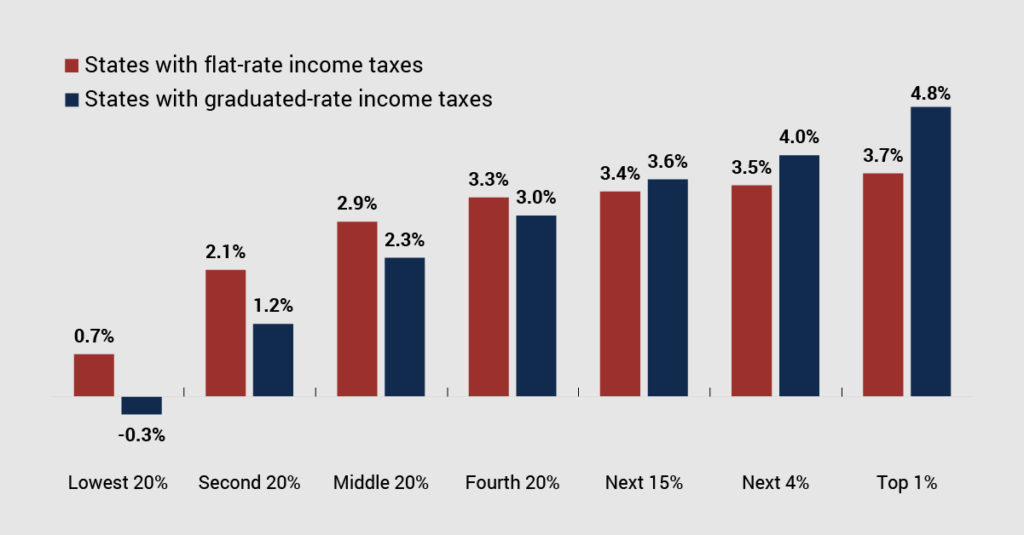State Rundown 1/19: ITEP Provides a Roadmap for Equitable Tax Goals in 2023
State legislatures are buzzing as leaders and lawmakers jockey to advance their 2023 goals. While the continuation of top-heavy tax cuts remains possible, ITEP’s Eli Byerly-Duke and Carl Davis have provided policymakers with information to push back against misguided flat tax policy proposals. The two find that, among other things, flat income taxes are not meaningfully simpler than other tax structures and often result in higher overall taxes for families with modest incomes. Luckily, for those still under the influence of tax cuts, State Policy Analyst Miles Trinidad along with State Policy Director Aidan Davis released a sobering outline for why the persistent push by lawmakers to make permanent tax cuts that provide a boon for the wealthy and little for the rest of us is a mistake. Instead, the pair argue that lawmakers should focus on ways to deeply invest in critical economic and social priorities. In a companion piece, they also elevate the importance of refundable credits in improving family economic security and advancing racial equity and highlight their continued momentum in 2023.
Major State Tax Proposals and Developments
- MICHIGAN state Treasury officials are expecting a $9.2 billion surplus at the end of the fiscal year, which could trigger a permanent cut to the state’s income tax due to a 2015 trigger law. If it is triggered, the income tax is estimated to be reduced from 4.25 percent to 4.05 percent (more on Michigan below). — MILES TRINIDAD
- New NEBRASKA Gov. Jim Pillen held two recent press conferences. In the first, Pillen laid out his proposal to revamp school funding by implementing a per-student minimum amount of state foundation aid, more special education funding, a cap on school spending growth, and supermajority requirements to ratchet local education funding downward over time; responses to these ideas were mixed. In the second, lawmakers summarized a series of tax plans, many of which would use the state’s current healthy fiscal position to slash taxes for upper-income households and corporations, including by reducing top income tax rates or abolishing the progressive income tax rate structure completely. In contrast to those regressive ideas, another lawmaker introduced a thoughtful plan to provide a state Child Tax Credit to boost incomes for middle- and low-income families. —DYLAN GRUNDMAN O’NEILL
- SOUTH DAKOTA lawmakers introduced legislation to repeal the state’s sales tax on groceries. The legislation was introduced with bipartisan support and follows Gov. Kristi Noem’s reelection campaign promise to end the tax. —MILES TRINIDAD
- MINNESOTA Gov. Tim Walz released his budget proposal, and within, it includes a new $1,000 refundable Child Tax Credit for qualifying children and an expansion of the state child and dependent care credit. The CTC is targeted in its approach and would phase out for families earning more than $50,000. For the CDCC, households with less than $200,000 could get up to $4,000 if they have one child, double that for two kids, and $10,500 for three. —MARCO GUZMAN
- WISCONSIN Senate Majority Leader Devin LeMahieu proposed eliminating Wisconsin’s graduated rate income tax in favor of a flat income tax of 3.25 percent: a more than 50 percent personal income tax cut for the wealthiest taxpayers. The proposal faces near certain opposition by Gov. Tony Evers. — ELI BYERLY-DUKE
Governors’ Annual Addresses and State of State Speeches
- COLORADO Gov. Jared Polis called for reducing property taxes and expressed his long-term desire to eliminate the state’s flat income tax in his 2023 address to the state.
- RHODE ISLAND Gov. Dan McKee proposed a $100 million tax relief plan as part of his budget proposal. The proposal includes reducing the state’s sales and corporate minimum tax, stopping the gas tax increase, providing energy bill rebates, and ending the litter tax for businesses.
- WEST VIRGINIA Gov. Jim Justice’s proposed a 50 percent cut in the state’s personal income tax—a cut that would cost about $1 billion in FY2024 and take Gov. Justice’s proposed budget into the red. The West Virginia House passed the bill, but it faces uncertain prospects in the Senate.
State Roundup
- With a surplus of over 2.7 billion, ALABAMA lawmakers are working on a plan with Gov. Kay Ivey that includes a one-time rebate of at minimum a $200 for single filers and $400 for married couples. They are also working on tax cuts, but details of those efforts are less clear.
- CONNECTICUT Gov. Ned Lamont proposes to restore the state’s pass-through entity tax credit, a workaround for businesses to avoid the federal “SALT Cap” on state and local tax deductions, to its original level.
- HAWAII’s 2023 legislative session began this week. Lawmakers have a budget surplus this session and they want to tackle housing reform. One legislator has already started. Senator Karl Rhoads drafted Senate Bill 55 (SB55), which would increase the tax credit for renters and the amount of those credits would increase every three years based on the consumer price index.
- MICHIGAN Gov. Gretchen Whitmer and other Democratic leaders announced legislation that would repeal the state’s retirement tax and expand the state’s Earned Income Tax Credit. The announcement follows Gov. Whitmer’s reelection campaign promise to repeal the retirement tax and EITC reductions implemented by former Republican Gov. Rick Snyder in 2011.
- A MONTANA bill backed by Gov. Greg Gianforte that would cut the top income tax rate from 6.5 percent to 5.9 percent and increase the state Earned Income Tax Credit from 3 percent to 10 percent will be brought before legislators this week. The bill would cost $250 million over the next two years.
- OKLAHOMA Rep. Jacob Rosencrants has authored House Bill 1039 (HB1039), which would add school supplies to the items to list of eligible exemptions from sales tax during Oklahoma’s tax-free weekend. The bill would make footwear and clothing items less than $75 and school supplies less than $50 tax-free.
- The PENNSYLVANIA Senate passed legislation to end the state’s automatic gas tax increase. The legislation would permanently set the wholesale price of gas to $2.99. Ending the increase could impact state infrastructure projects as revenue from the tax is used to fund highway and bridge construction.
- In SOUTH CAROLINA, Gov. Henry McMaster urged lawmakers to drop the state’s income tax rates faster than intended (from 6.5 percent to 6.4 percent). Senate leaders seem amenable, but the House Chairman says he would rather wait to see how the economy performs. The House Minority Leader argued lawmakers should prepare for an economic downturn rather than focus on more tax cuts.
- In TEXAS, House leaders unveiled their starting point for the 2024-25 state budget in House Bill 1 (HB1). Their plan, predictably, included property tax cuts, this time through a $3.1 billion appropriation for buying down school districts’ property tax levy, The Senate has not released their plans yet, but in the Lt. Governor’s Inaugural Adress he said the Senate package would increase the homestead exemption. In his inaugural address, Gov. Greg Abbott reaffirmed his commitment to cutting property taxes.
- UTAH legislators have begun to discuss their 2023 priorities and among them are cutting the state income tax. Members of the Democratic caucus, however, want to take a more targeted approach, like ending the sales tax on food.
- A WYOMING bill that would have eliminated sales tax exemptions and cut the sales tax rate from 4 percent to 2.5 percent stalled in the House.
What We’re Reading
- The Washington Post reports on a multi-state effort we also cover here, in which several states are taking matters into their own hands to apply taxes to the fortunes of the nation’s wealthiest households and the income generated by those fortunes. This is an area ripe for reform, as we highlight in our 2022 report detailing the geographic distribution of extreme wealth in the United States.
If you like what you are seeing in the Rundown (or even if you don’t) please send any feedback or tips for future posts to Aidan Davis at [email protected]. Click here to sign up to receive the Rundown via email.





